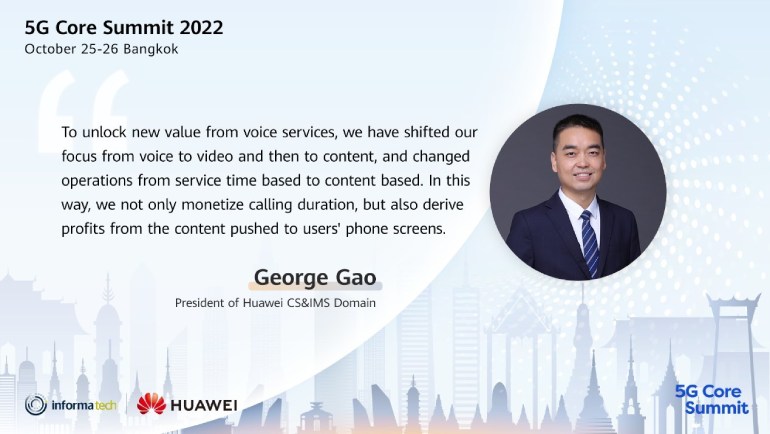 At the 5G Core Summit 2022, George Gao, President of Huawei CS&IMS Domain, delivered a speech titled From Voice to Video and Content, 5.5G Core Unleashes the Vast Potential of Calling. He elaborated on the strategies and evolution involving the 5.5G-oriented voice network, from voice to video and then to content, which further consisted of minute-level operation to content operation. He emphasized the values and profits on mobile phone screen content, not just the call duration. George said that the 5.5G-oriented voice network further unleashes the vast potential of calling, and helps operators achieve commercial success.
At the 5G Core Summit 2022, George Gao, President of Huawei CS&IMS Domain, delivered a speech titled From Voice to Video and Content, 5.5G Core Unleashes the Vast Potential of Calling. He elaborated on the strategies and evolution involving the 5.5G-oriented voice network, from voice to video and then to content, which further consisted of minute-level operation to content operation. He emphasized the values and profits on mobile phone screen content, not just the call duration. George said that the 5.5G-oriented voice network further unleashes the vast potential of calling, and helps operators achieve commercial success.
The VoLTE penetration rate is greater than 80% and suitable for the withdrawal of 2G and 3G networks
VoLTE is fundamental in the 5G era, and all current 5G operators have already constructed VoLTE networks. To avoid multi-network operation, improve spectral efficiency, and gain more business benefits, hundreds of operators plan to shut down the 2G and 3G networks from 2022 to 2025, with traffic being migrated to VoLTE networks, preventing any potential fallbacks on such antiquated networks.
Calling is developing from voice to video and content
Voice calling is gradually evolving to video calling, delivering a greater variety of content during calls. More and more users are willing to pay for personalized content. The VoLTE-based video RBT service has been developed to enable users to express themselves and deliver enterprise content, which has achieved a positive business cycle within the China markets.
At present, some leading operators are vigorously developing VoLTE/VoNR-based video calling. With higher quality, faster connections, data-free, and ease of use, video calling becomes more and more popular and can be quickly developed as a basic service.
Leading operators are building calling-based platform products to maintain user loyalty
Based on voice and video calling, leading operators are launching more innovative services such as New Calling.
- Lighting up screen: With the popularity of Bluetooth headsets, the method in which users are answering calls is changing. This provides a good opportunity for operators to add value by lighting up users' phone screens during voice calls so that they can present their virtual images, share content, and show their personalized information without turning on the camera.
- Fun video calling: Image recognition and media rendering are implemented through intelligence techniques to make calls fun and efficient. For example, users can use functions such as background replacement, AR virtual avatar, and voice or gesture-controlled emoticons to express their emotions.
- Intelligent translation: Intelligent translation is introduced into the calling network which utilizes voice-to-text conversion and real-time cross-language translation to achieve barrier-free communications.
- Interactive video calling: Interactive video calling is developed by adding a data channel to enable services, such as visual menus, screen sharing, file signing, and remote assistance. Each enterprise number can be bound to a mini app. When a user dials such a number, the app automatically displays a screen and completes the transaction during the call.
New Calling with "1+3+N" redefines calling services
To help operators build calling-based platform products, Huawei has launched New Calling with a "1 platform + 3 capabilities + N services" architecture. The platform brings services such as UHD video calling, lighting up screen, intelligent translation, fun video calling, and remote assistance into reality, accelerating service innovation and unleashing the value of communications across multiple industries.
George Gao emphasized that calling is developing from voice to video and then to content, from minute-level operation to content operation, which creates values and profits on mobile phone screen content, not just the call duration. This will further unleash the vast potential of calling. (Source: Huawei)
By MediaBUZZ


